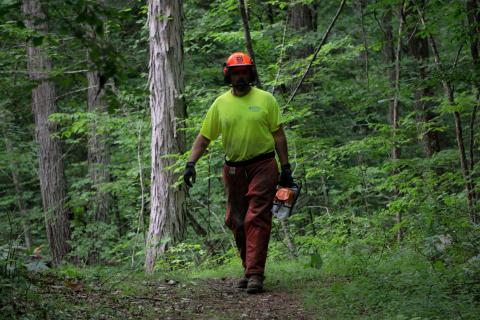Staying Safe in the Woods

There are multiple facets to woods safety, any one of which can be described in great detail. But there are some basic rules to staying out of harm’s way while spending time in the woods, whether it be hiking, hunting, cutting firewood, or visiting a logging job on your land.
General safety
It’s helpful to be aware of a number of factors before heading into the woods for the day, such as the terrain, forest conditions, and the weather. Knowing if you’ll be climbing steep terrain, crawling over blowdowns, and crossing streams in the rain will help determine what clothing and gear to bring.
New England weather changes regularly, so be prepared. Bring several layers of clothing, have a hat and gloves, and a rain jacket. Extra clothing can be carried in a small pack. Wear clothing made from materials that stay warm even when wet, such as wool or synthetics. Avoid cotton—which does not trap heat—at least for layers next to your skin.
If you are planning to travel off trail, bring a map and compass, and know how to use them. GPS is useful, but don’t depend on it. Signals get weak and batteries run low. Bring a flashlight or headlamp, in case you’re in the woods at dusk or after dark. This time of year, with the days getting shorter, it’s easy to get caught in the dark, and an overcast day gets dark even earlier.
When visiting a logging job
Safety is paramount when visiting a logging job. If possible, let the logger know when you are planning to visit, so they know to keep an eye out. Wear basic safety gear: hardhat, eye protection, closed toe shoes, and high visibility clothing. Stay a safe distance from operating machinery and tree felling. A rule of thumb is at least two tree lengths – and up to 300 feet from a feller buncher and its spinning saw.
Don’t approach an operator until you’re sure they’ve seen you. Try to have a pre-arranged signal – a wave, flashing lights, shutting off the machine – that indicates that the operator has seen you and it’s safe to approach.
Other considerations when visiting a logging job are to look for overhead hazards created by felled trees; to stay away from log piles, which can be unstable; when machinery is traveling by, be mindful of standing dead trees that can be bumped by the machine, and wood on the ground that can kick up when travelled over.
When cutting trees
If you cut your own trees, for firewood or other purposes, a whole new level of safety needs to be considered, and is a topic by itself. Any number of hazards are encountered in the logging woods. Wear the proper personal protective equipment (PPE): hardhat, eye protection, hearing protection, chainsaw resistant chaps or pants, steel toed boots.
Get training in proper chainsaw use. There are classes on how to use a chainsaw safely and productively when felling, limbing, and bucking trees, through the Game of Logging and other venues.
Other considerations
In addition to the basic precautions, be sure to consider the season. Winter has snow and cold of course, but other seasons bring their hazards as well. Be aware of ticks during any snow-free month – I found a tick on November 5th this year. Wear clothing that is chemically treated to repel ticks, tuck pants into boots, wear light-colored clothing for easier detection, and most importantly, do a thorough check when you return from the field. Fall is hunting season. Wear blaze orange or other high-visibility clothing. Have your pets wear it too.
Although any number of hazards can be encountered in the woods, following basic precautions and being aware of your surroundings can keep you safe and enjoying the outdoors for years to come.
Jim Frohn is the Grafton County Forester with UNH Cooperative Extension. To learn about forest management and more visit www.nhwoods.org.
